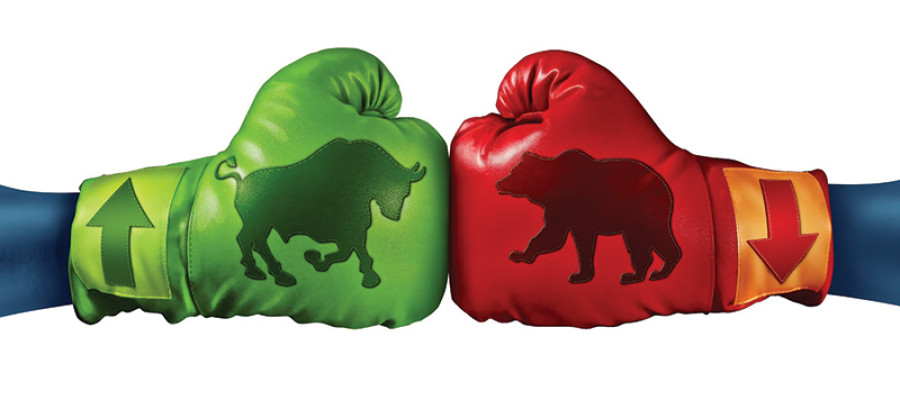Opinion
Let short-selling begin
Shorting injects much needed balance into the markets now that margin trading is allowed
Paban Raj Pandey
Over the long run, as the economy develops, and as people’s income and living standards rise, stocks’ probable path is from the lower left to the upper right
Nepal’s nascent stock market is about to take another baby step toward adulthood. The history of stock investing is not even 25 years old. The Securities Board of Nepal (Sebon), which regulates the nation’s securities markets, was established in June 1993. Nepal’s only stock exchange, the Nepal Stock Exchange (Nepse) began trading in January 1994. So it is only fitting that a lot of the tools that are considered standard in mature markets do no yet exist in Nepal. Margin trading is one. Early this month, Nepal Rastra Bank, the central bank, gave the go-ahead to margin trading. Buying securities with borrowed money is referred to as buying on margin. Investors in Nepal will soon be able to borrow funds from their brokers using securities as collateral and use the funds to purchase shares. To trade on margin, one needs to have a margin account. Typically, the broker charges interest on the loaned amount. If the value of the pledged shares drops by a certain percentage, the broker will issue a margin call, which obligates the client to either deposit more funds or sell the shares and pay back the borrowed money.
Useful if handled well
As with most things in life, margin trading comes with pros and cons. Most important perhaps, it provides more liquidity. As per the Nepse guideline, brokers with net assets of Rs50 million can offer such services, and can issue margin loans of up to 50 percent of the value of the shares based on the 180-day average price or the prevailing market price, whichever is lower. In essence, this translates into more credit creation. By enabling them to buy more than they can afford to, investors’ buying power gets multiplied. In a rising market, this can magnify gains, which also means the reverse is true when bad times hit. Leverage is a double-edged sword. Margin accounts get tested when a trade turns sour. Worse, when a broker issues a margin call and the client is unable to meet his or her obligations, accounts can get blown up. If instead it is done with discipline and prudence, margin trading can be a useful tool—not only for market participants but for authorities as well. A little history lesson involving US markets can help.
In the US, the Federal Reserve’s Regulation T governs the extension of credit by securities brokers and dealers. The initial margin requirement for stock purchases has remained unchanged at 50 percent since 1974. The requirement was introduced in 1934, and for 40 years it ranged between 50 and 70 percent. The Fed has the authority to change that. If, for instance, the margin requirement is raised, not only does it help reduce leverage in the system, but also sends a signal that the central bank would like less risk-taking.
In December 1996, the then-Fed chairman Alan Greenspan used the phrase ‘irrational exuberance’ to describe how US stocks were behaving at the time. It was apparently a veiled warning that stocks were overvalued. The S&P 500 large cap index was 740 when he made those comments, and it would not peak until the bubble burst in March 2000 at 1553. It then collapsed 51 percent by October 2002. Hindsight is always 20/20, but use of higher margin lending requirements would have probably sent a powerful message that the Fed was growing concerned about higher multiples. Incidentally, the New York Stock Exchange (NYSE) margin debt was $97.4 billion in December 1996. By March 2000, it had ballooned to $278.5 billion. Investors were on a debt binge, and the strategy worked—until it did not. Margin debt then fell to $130.2 billion by September 2002. Investors were forced to sell to meet margin calls. As the decline gained momentum, selling begat more selling.
Margin cuts both ways. In Nepal, it is a new tool, and as investors begin using it, stocks—at least initially—can come under upward pressure, as new buying kicks in. Thus the need for the authorities concerned to monitor it closely. In any market, the majority only prepares for up markets, and it does not take long before bullish sentiment gets out of hand. This is particularly so in Nepal as tools to bet the other way do not yet exist. Shorting is not allowed. There are no options and futures. But in markets money can be made both ways—regardless of whether a stock goes up or down.
Shorting, or short-selling, lets market participants bet that a stock is headed lower by borrowing shares and immediately selling them. After the shares drop, they are bought back and returned to the original owner, pocketing the difference as profit. Apparently, short-selling plays an important role in the functioning of markets. In any market at any given point in time, there are optimists, and there are pessimists. They both play a role. If there is excess optimism, a contrarian investor would like to bet against that. Along the same lines, if there is excess pessimism and shorts are too active, they can eventually get squeezed. In a short squeeze, burned shorts are forced to buy back, putting upward pressure on the security, helping the longs.
Short interest
Similar to margin debt, short interest (number of shares sold short but not yet covered or closed out) can be used as a sentiment indicator. Once again, using the US as an example, during the 2008 financial crisis, as stocks came under pressure, NYSE short interest began building. By the end of July, it reached 18.6 billion shares—a record. The S&P 500 bottomed next March. The bull market that began back then is still alive; initially, shorts lent a big helping hand as they were forced to buy back. By January 2012, short interest fell to 12.5 billion.
Currently in Nepal, pessimists have no way of putting their money where their mouth is, other than to sell and wait,
hoping to buy back when stocks go lower. This naturally lends itself to an up bias—arguably artificial, at least at times. Over the long run, as the economy develops, and as people’s income and living standards rise, stocks’ probable path is from the lower left to the upper right. But it is never straight up. There will be swings, and cycles. Short-selling would allow those with the necessary skill set to take advantage of the downswing. This, in turn, injects balance into the markets, which will be much needed now that margin trading is allowed.
Pandey specialises in portfolio investment & economic issues.




 19.12°C Kathmandu
19.12°C Kathmandu










